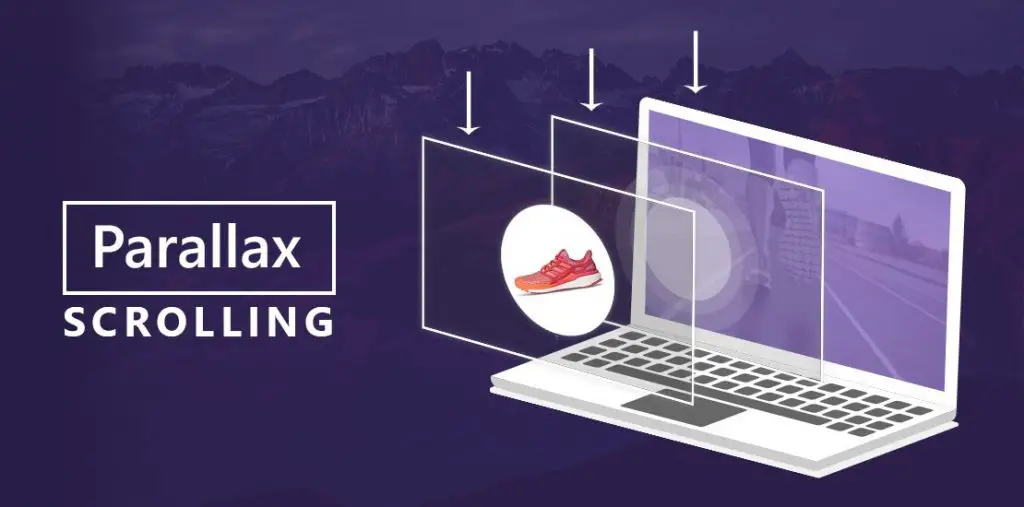Parallax web design is the brainchild of HTML and coding along with the principles of optical illusion.
Multiple slides of images and videos are used at varying speeds to create a 3D effect.
When it was first introduced in 2011, it wowed the internet and made way to a new, exciting form of visual storytelling.
It was immersive and impressive. Ecommerce brands were smitten by it.
Everyone wanted to go at this design, from professional photographers, bakers, jewelry artists, and makeup brands.
It was based on the optical effect of closer objects appearing to move faster and farther away ones moving much slower.
In a parallax design, the background image or video moves at a different pace when compared to other elements on the screen. This broke the monotony of other static web designs and gave more importance to visual elements.
This design showed encouraging results of a hike in dwell time, people engaging more in CTA buttons, piqued curiosity, and lesser bounce time.
But it had considerable disadvantages too, especially with regard to SEO and page load time.
6 Downsides of Doing SEO for Parallax Design Websites
Though parallax design delivers a gratifying user experience, it doesn’t support any features necessary for SEO.
Time and again, experts have emphasized the damage parallax design can do to one’s SEO efforts. As it mainly consists of one to two pages, there is lesser content to optimize.
Multiple data-heavy videos and images are used to create this design; it takes much longer than a regular website to load.
Moreover, there are only one or two header, alt tags, and metadata to optimize. This makes it harder for users to find your website in a sea of options.
Scroll down to take a look at these cons in a detailed manner. This will help you to decide whether aesthetics are more critical than functional elements like SEO.
1. Limited Space to Showcase Keywords
Websites with a parallax design are mostly made up of one to two pages and never more. And the informational content is presented in one long stretch.
This dramatically limits the quantity of content you can display. And this, in turn, reduces the number of keywords that can be used. This makes it much harder for users to spot your website on search engines.
Also, there is a high chance that people get tired of monotonous scrolling, and they might give up reading anything on your site altogether. Most find it tedious to scroll through irrelevant information to see what they want at the bottom.
This hurts two significant SEO factors- dwell time and visibility.
2. Takes Too Long to Load
The main selling point of parallax designs is their aesthetic appeal. They are colorful and exciting. But the pleasing exterior has its downfalls too.
As this design requires data-heavy pictures and videos, it becomes harder to compress them. This makes the page load much slower than normal.
According to Google, page speed is one of the five high-ranking factors for SEO since 2010. As per Akamai’s report, 40% of online users will abandon a site if it loads for more than three seconds.
Any compromise on this factor will take a toll on your page rank and overall online popularity.
3. Adapting for Mobile is Cumbersome
Parallax designs are hard to be adapted to mobiles due to their unresponsive core design. The core of a website can be altered to be mobile-friendly, but it costs a lot.
This, yet again, pulls down a crucial SEO factor, mobile-friendliness. It drastically reduces the usability value of a website which is keenly looked at by Googled.
Sometimes, companies create separate designs for mobile, apart from having a parallax one for the desktop version. This is looked at as duplicate content by Google, and it brings down the genuinity and user experience of your site.
Mobile-friendliness is a key ranking factor for SEO as people spend 70% of their time on mobiles, and 76% of users shop on mobiles.
4. Makes Websites Harder to Find
All parallax websites have only one URL. This means you can use only a few keywords in the URL.
Chances of search engines and your target audience picking your content up are reduced by more than half.
Moreover, one URL can be indexed only once, even though your design might have three to four other pages. The algorithms of search engines don’t allow fragmented pages to be indexed. They need to be whole.
Also, there are fewer title tags, alt tags, H1 tags, and metadata. This cuts down the scope of adding your niche relevant keywords in all these spaces.
5. Lesser Scope for Interlinking
All the information will be displayed on one long webpage; there is no logic behind interlinking here. It doesn’t take you to an external page because it doesn’t exist.
And this brings down your effectiveness for SEO as interlinking is considered to be a sign of credibility.
Fewer interlinks also mean fewer pages for search engines to index, and lesser keywords will be picked up. It also is more challenging for you to convince Google that your website is informational for its readers.
This reduces your organic search visibility and will harm our organic search traffic numbers to a large extent.
Read here about the impact interlinking can have on your SEO performance.
6. Hard to Track Results with Analytics
There are no external landing pages in a parallax design; it is difficult for analytical tools to figure out which area is problematic.
Online marketers will find it hard to discover which part of the website is working and which isn’t. This makes progress more cumbersome to achieve. Owners won’t know which segment to improve.
This way, you cannot use the tools available online to analyze your performance. It won’t be easy to assess your online reputation, brand awareness, value, and exposure without this.
How to Do SEO for Parallax Design Websites?
It is possible to make a single page optimized for SEO so that users can find your website.
While most experts are rigid on this concept and advise against having a parallax design, it is possible to have both- functionality of SEO and aesthetics of parallax.
Parallax is a good way to ensure user satisfaction. And when it’s optimized for SEO, your page rank and overall online reputation will also be secured. It’s a win-win.
One way to go about this would be to have multiple pages with subtle touches of 3D effect. You can have only a few select pages entirely done with parallax. Pages with maximum content can be left as it is.
It takes more effort to make a parallax design SEO-friendly when compared to normal pages. But it will be worth the effect due to the high appeal of its visual storytelling.
Let’s look at five methods that make parallax designs SE-optimized.
1. Split Pages
Google itself has shown a way to overcome the difficulty of working with a single URL.
A blog post has explained in detail about splitting one page into multiple zones so that search engines can crawl better and understand the content more easily.
This method is called pagination, where each piece will have a separate title tag, head tag, and link. More keywords can be added this way. Each section can be optimized better for SEO.
In this way, different sections are formed, which Google can crawl through faster.
2. Interlink to Blogs & Guest Posts
Creating blogs is an excellent way to bypass the problem of keyword scarcity in parallax designs. It is also an effective way to generate more interlinks.
Another way is to collaborate with freelance writers, content writers, and bloggers and interlink their work on your single-page parallax website.
To be more original and genuine, you can employ a small internal team to write blogs with fresh content. You can update it weekly or daily to engage more organic traffic.
This way, Google will consider your website a point of non-plagiarized, relevant, and knowledgeable information. This is a very effective way to improve your SERP rankings by working solely on content.
This requires you to learn about current, trending topics in your niche and find suitable keywords for them.
3. Create a Design for Mobile First
To ramp up the responsiveness of your parallax website, create the mobile version first.
Most people struggle to adapt their parallax desktop design to mobiles and lose out on usability points with Google. Instead, reverse this practice.
Another way is to cut out the data-heavy animations and 3D designs for mobile. Add only certain parallax elements to the mobile design so that it’s not choppy and doesn’t hang.
You can also ask the designer to have an automatic turn-off switch for parallax design in a mobile environment. It will get activated when people access your website from their mobiles.
This way, you can still retain the pros of optical illusion in your desktop design.
For a more advanced approach, you can build parallax designs for mobile with CSS3 transformations with the help of libraries like Scrollability and iScroll.
4. Make More than One Entry Point to the Website
The problem with having a single page is that it has only one URL, one H1 tag, and only one set of metadata. This means people can access your website only from one link.
This brings down the ease of finding your website. It directly affects overall visibility and usability.
One way to overcome this is to increase the metadata load by having multiple web pages through pagination.
Another tip is to make sure that title tags, canonical tags, and meta descriptions are directly rendered into the source code of the webpage.
5. Reply on CSS More for Quick Page Load
One of the biggest deterrents of having a parallax setup is slow page speed.
As they contain data-heavy images and videos, users have to wait longer than two seconds to access the website. This automatically curbs their interest and makes them switch to other pages.
Coding experts recommend relying more on CSS rather than JavaScript while writing and developing the website.
Parallax is a mixture of both, but try using more CSS components to enhance page load time.
One more way is to have a balance between parallax and standard web page design. Use 3D effects only for the homepage and leave the rest of it as it is.
Or add small parallax elements here and there to capture user interest. This can be done for the call to action buttons too.
Parallax Web Design & SEO FAQs
1. Is Parallax Scrolling Good or Bad for SEO?
Due to its single-page structure, parallax design isn’t the suitable layout if you want to enhance your SEO performance.
It is most definitely not the first choice. It makes it harder for users to find your website and the content your company has curated.
Search engines like Google cannot crawl or index it correctly as there is only one URL, the header tag, title tag, and one set of metadata.
This limits keyword density as well. Moreover, parallax websites are notorious for taking too long to load.
Also, it is not compatible across all browsers as well. A design that works in Chrome might not open in the Firefox browser. This is taken into account by Google.
2. How Does Parallax Scrolling Work?
Parallax design creates an optical illusion of images and videos playing at different speeds. This relative movement creates a 3D effect making the design alluring to users.
They consist of many layers of media, placed in front of each other in varying speeds, colors, and themes.
Parallax is like the extra effect you add to your PowerPoint presentation slides. It creates drama and makes the user experience immersive.
3. What Are the Benefits of Parallax Web Design?
Parallax makes your website attractive and exciting and urges users to explore its contents.
It is an excellent tool to enhance user experience. It also helps in increasing the dwell time and decreasing the bounce rate.
It helps in holding their interest and attention for a longer time than regular websites do.
Images and videos speak for themselves without much input from your side.
This is highly advantageous for generating new leaders, rebranding, and launching a new product or brand.
It is a great method for immersive storytelling. And you can put all the information in one slide.
4. Has Parallax Design Gone out of Trend Today?
Yes and no. Companies have taken the principle of parallax and applied it to a few elements across their website.
It is still one of the widely used designs due to the attention it stirs up. But instead of completely engulfing the website in parallax, select pages and sections are made on this concept.
This way, the benefits of both visual storytelling and SEO are retained. Popular brands like Nike, Adidas, etc use this design to launch a new product or celebrate a landmark event.
Parallax designs evolved since 2011 and are now upgraded to become SEO-friendly.
5. How to Have Parallax Design with Good SEO Performance?
There are many ways to go about this. And even minor adjustments have brought good improvements to SEO performance.
Firstly, you can use this design on some elements or select pages only. For example, you can make the home page and contact us page with amazing photos and videos. This way, you will leave a lasting impression on your target audience.
Secondly, you can make sure your designer uses more CSS script to build the code of your parallax design and only a little of Java to increase page speed.
Thirdly, you can split the long page into smaller sections and create metadata for each. This way, you can add more keywords.
Lastly, you can interlink blogs, articles of freelance writers, and bloggers to the main page to increase keyword density.
Author BIO:
Joseph Schneider is the Director of Marketing at Haitna. He is passionate about writing content related to search engine optimization, social media marketing, and influencer marketing with the hope to make a difference and contribute to their business growth









0 Comments